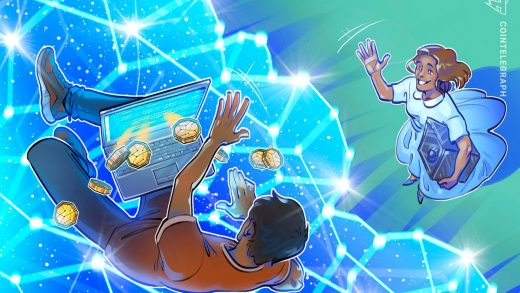Key takeaways:
-
With inflation at 229%, daily prices in Venezuela are set in USDT “Binance dollars,” usually at live P2P rates.
-
Three dollar rates exist (official, parallel and P2P), but merchants mostly follow the P2P quote.
-
The government tolerates dollar-backed crypto in exchanges, though it hasn’t legalized dollarization.
-
Venezuela is a global crypto hotspot: Stablecoins dominate small transfers, mostly via TRC-20 USDT.
In Caracas, receipts now often show totals in “Binance dollars” because pricing has moved off the Venezuelan bolívar and onto the blockchain.
With annual inflation around 229% as of May 2025, everyday prices track three references: the central bank of Venezuela’s (BCV) exchange rate, the parallel “dólar negro” and a Tether USDt (USDT) peer-to-peer (P2P) rate many merchants actually use.
Gaps between them persist due to capital controls, thin or separate liquidity pools and periodic interventions.
To avoid constant repricing in bolívars, now merchants quote, settle or reconcile in USDT. That’s basically dollarization built on stablecoins rather than cash.
What are “Binance dollars?”
Locally, “dólares Binance” means USDT priced and settled on P2P markets (most visibly, Binance P2P).
For shops, freelancers and building administrators, that P2P quote acts as both the day’s reference price and the payment infrastructure.
Other apps and over-the-counter (OTC) desks exist, but deep USDT liquidity keeps this benchmark dominant.
Transfers are usually on Tron (TRC-20): fees are minimal, wallets are widespread, and digital dollars are easier to source and pass around than scarce paper USD (especially for small, frequent payments).
How USDT “replaced” cash in Venezuela
Three pressures pushed Venezuela’s dollars onto the blockchain.
First, inflation reaccelerated in May 2025 to roughly 26% month-on-month, keeping the annual rate well above 200%. Pricing in bolívars became unworkable; menus and invoices would need constant updates.
Second, the bolívar’s slide widened the gap between official and street pricing. Depending on the period, the currency lost about 30% in recent months and roughly 69% year-over-year (July 2024 to July 2025), so merchants sought a steadier unit of account.
Third, physical US dollars are scarce, a by-product of sanctions and constrained oil cash flows. Digital dollars (above all, USDT) proved easier to source, store and circulate through low-fee networks and ubiquitous wallets.
Policy nudged in the same direction. Quoting the parallel rate is still penalized, yet authorities have gradually allowed dollar-pegged crypto in private-sector exchanges to keep markets functioning, an implicit tolerance short of formal dollarization.
Adoption data adds to the picture. Venezuela sits among the leaders in grassroots crypto use, with stablecoins taking a growing share of everyday transfers.
In 2024, onchain activity roughly doubled year-over-year, and stablecoins made up about 47% of sub-$10,000 transactions, evidence that USDT now anchors pricing and settlement for households and small and medium-sized enterprises (SMEs).
Did you know? Since 2008, Venezuela has chopped 14 zeros off its currency across three redenominations (2008, 2018, 2021).
How a USDT payment actually works in Venezuela
At the register, prices are posted in USD but settled in USDT at the day’s local P2P quote, most commonly the Binance P2P rate Venezuelans track on their phones.
The cashier (or condo treasurer) refreshes that quote and shows the total, and you scan a QR code that encodes the merchant’s Tron (TRC-20) address. Confirmation lands in seconds; typical network costs are low, though you do need a small TRX (TRX) balance to cover fees.
Merchants then choose: hold USDT as working capital, swap part of it to bolívars through an OTC/P2P desk for salaries and utilities or forward USDT upstream to suppliers.
In practice, the P2P rate is the operational benchmark because it reflects liquid order books and can be executed immediately. Therefore, apartment buildings, small shops and freelancers reconcile against it rather than the central bank’s rate or informal quotes.
This workflow (USD listing, P2P conversion, TRC-20 transfer) now supports everyday payments in the country.
Who uses it and for what
Households use USDT for groceries, condo fees, rent top-ups and peer-to-peer reimbursements to sidestep price shocks in VES (Venezuelan bolívar).
Small and medium-sized businesses restock imports quoted in dollars, keep management accounts in USD for clarity and convert selectively to VES for payroll, utilities and taxes.
Employers in retail and services sometimes pay bonuses or a portion of salaries in USDT to retain staff and protect purchasing power, while larger entities tied to public procurement continue to align formal accounting with the BCV reference even if day-to-day operations lean on P2P pricing.
For many participants, the appeal is practical: With a phone and a basic wallet, they can hold, receive and send digital dollars without hunting for scarce cash.
Did you know? Venezuela’s diaspora tops 7.7 million-7.9 million people (one of the world’s largest displacements), supercharging crypto remittances back home.
Frictions, risks and how people mitigate them
The shift doesn’t come without its challenges, however.
-
Rate risk and reconciliation: Quotes tied to live P2P books can move intraday; a delay of even an hour can leave a payment short or over the mark if VES shifts. Common mitigations include timestamped invoices, short payment windows, “Pay Now” buttons that refresh the quote and immediate settlement/reconciliation at day’s end.
-
Custody and device security: Phone theft and seed-phrase loss are real operational risks. Users mitigate with PIN/biometric locks, wallet passcode timeouts, offline backups of recovery phrases and (above a threshold) moving balances to hardware devices or account-abstraction wallets with social recovery.
-
Platform dependence and blacklisting: USDT is centrally issued and can be frozen in certain circumstances. To reduce exposure, merchants keep operating balances modest, spread funds across more than one wallet, avoid risky approvals and maintain simple off-ramps.
-
OTC/P2P fraud: Off-platform deals and fake payment screenshots still occur. Standard practice is to use on-platform escrow, trade only with high-reputation counterparties, wait for onchain confirmation and require verifiable proof-of-payment before releasing goods.
-
Policy gray zone: Authorities have penalized quoting the parallel rate even as they gradually tolerate USDT in private-sector exchanges. Operators protect themselves by avoiding explicit parallel-rate references on invoices, keeping clean records, separating pricing from accounting currency where required and monitoring rule changes closely.
Did you know? In August 2024, access to Binance was intermittently blocked by state-owned ISP CANTV amid post-election unrest, highlighting platform-dependence risks for P2P users.
Digital dollars take hold
Venezuela is experiencing de facto dollarization routed through crypto.
Unlike the 2019-2022 phase, when cash dollars informally dominated shop counters, today the unit of account and much of the settlement liquidity come from stablecoins (chiefly USDT) without any change to legal-tender laws.
The logic is regional: In high-inflation economies such as Argentina, stablecoins anchor everyday transactions, remittances and working capital because they provide dollar pricing with low-friction transfer across widely used wallets and P2P markets.
Policymakers are adjusting at the margins; Venezuela now allows dollar-linked crypto in private-sector currency exchanges to keep commerce moving, but this remains a pragmatic workaround rather than a formal dollarization decree.
More broadly, dollar-backed stablecoins extend the dollar’s reach into daily payments and small-ticket transfers, which is why, when local money is unstable and cash is scarce, digital dollars become the path of least resistance for households and SMEs.
This article does not contain investment advice or recommendations. Every investment and trading move involves risk, and readers should conduct their own research when making a decision.


